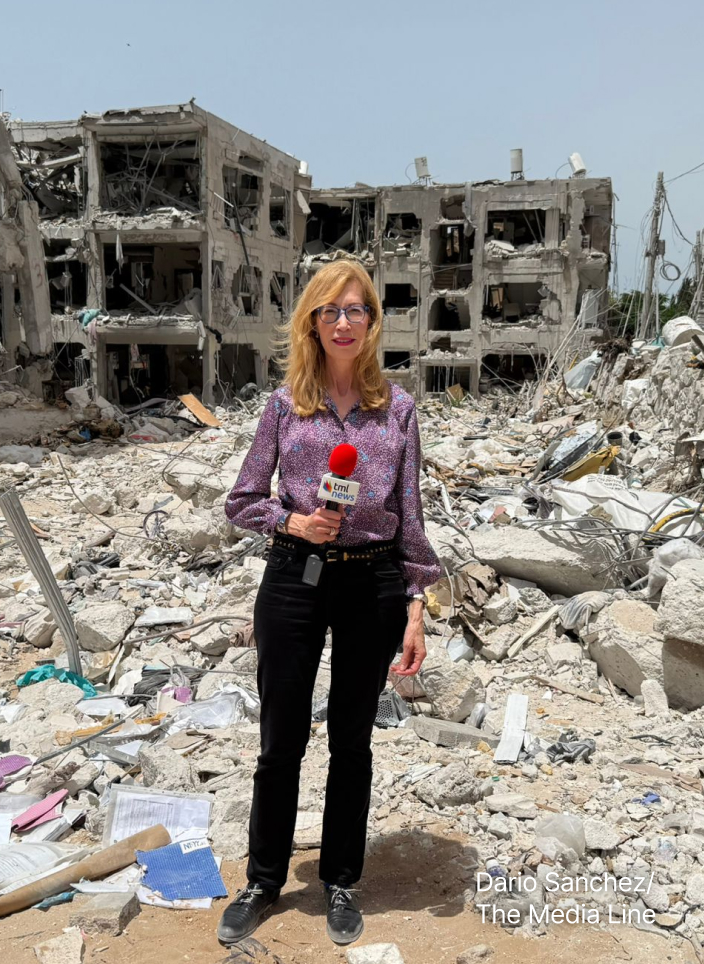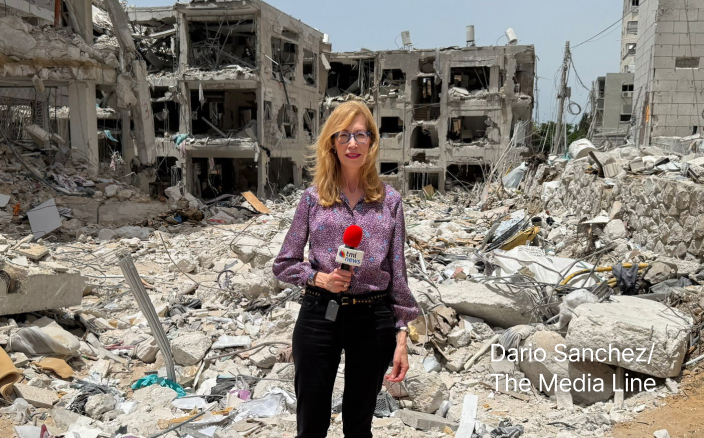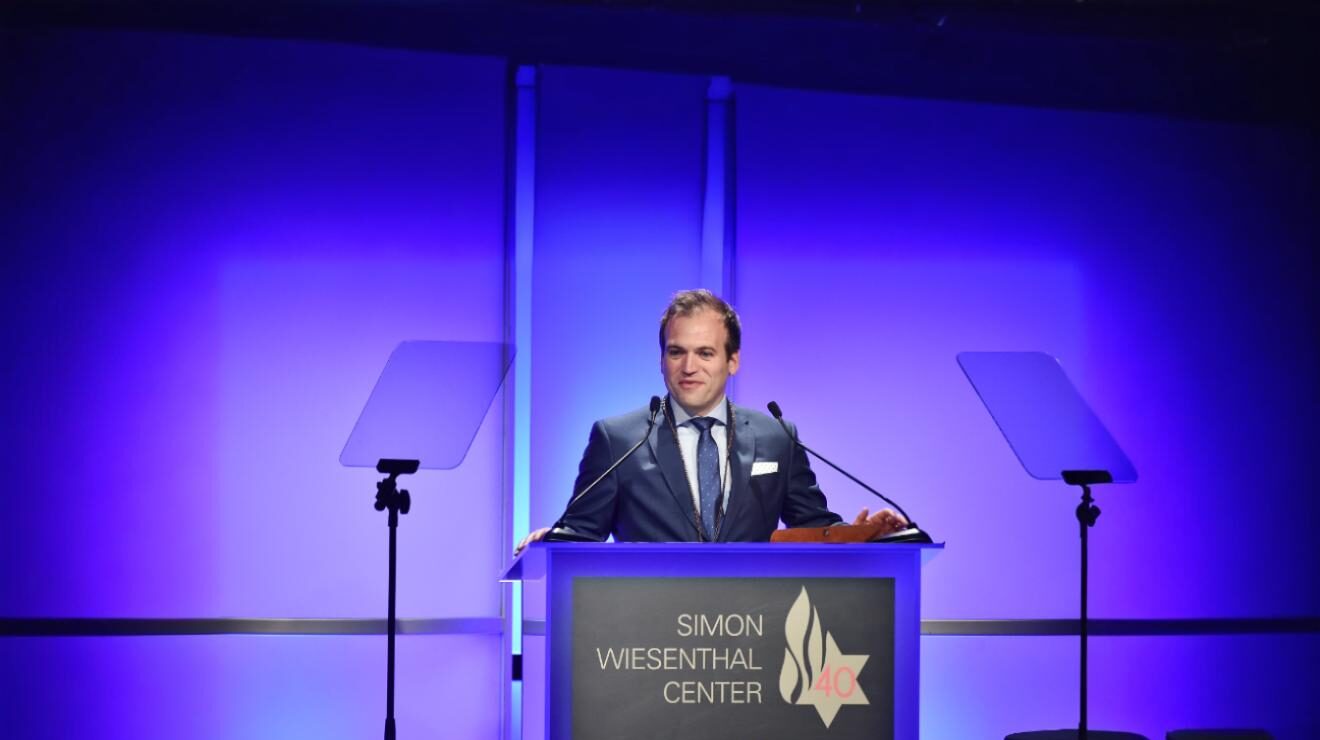Rev. Moore Defends Controversial Gaza Aid Operation, Tells TML Almost a Million Fed
In an exclusive interview, the Gaza Humanitarian Foundation chairman debunks misinformation around the Gaza aid distribution and says it will take $150 million per month to service all of the enclave
Reverend Johnnie Moore has spent most of his adult life walking through the political minefields of the Middle East. But even with decades of experience navigating cynicism and conspiracy theories, he says nothing quite prepared him for the storm surrounding his latest mission—chairing the Gaza Humanitarian Foundation (GHF).
“I did not anticipate the level of insanity that I’ve experienced the last few weeks,” Moore told The Media Line’s Felice Friedson. “Not because we haven’t seen all of this before, but we sort of knew that GHF would be something that Hamas wouldn’t like.”
GHF, a US-backed humanitarian effort distributing food aid directly to Gazan civilians, has become both a flashpoint and a lifeline. Moore says the foundation has distributed more than 75 million meals in just six weeks through four “secure distribution sites”—while navigating fierce opposition from Hamas and, unexpectedly, parts of the international aid system.
To hear Moore’s full remarks, including his take on Hamas’ tactics, the UN’s response, and his recent meeting with Syria’s president, listen to the full interview with The Media Line.
‘We Knew Hamas Wouldn’t Like It’
From the start, Moore says, the team behind GHF understood the risks. “We knew Hamas, because they controlled humanitarian aid and they made billions of dollars off of it over years, they would feel somehow threatened by what we were doing.”
But the intensity of the backlash shocked him. “I had no idea, and I did not anticipate, that we would be kicking a hornet’s nest that included basically the very, very top of the United Nations, leaders of many of these revered humanitarian organizations,” Moore said. “And for whatever reason—I don’t quite understand it—when we want to work with them and they want to shut down, they have decided that they feel just fine using talking points and information they get from Hamas.”
Moore’s tone throughout the interview is more baffled than bitter. “I knew this would not be an easy task. There’s nothing harder than doing anything in Gaza. But I did not expect the level of intentional, vitriolic lying that we’ve experienced.”
Confronting Disinformation
Asked for examples of what he described as rampant misinformation, Moore didn’t hesitate.
“The first one is that GHF is meant to try to move Gazans, right? So this is an attempt to move Gazans, and we want to get them all in the south, and that’s why we’re distributing aid in the south,” he said. “And in actuality, our plan from the very beginning was to distribute aid across all of the Gaza Strip. We have plans to open up sites, both serving more in the center of the Gaza Strip and the north of the Gaza Strip. That’s been a plan from the very beginning. It’s still the plan.”
Another claim Moore rejected outright: that GHF distribution sites are scenes of daily bloodshed.
There hasn’t been a single massacre at our sites
“There hasn’t been a single massacre at our sites. In fact, there’s been no violence at all at our sites or within our sites, except for when Hamas threw two grenades at our American aid workers about 10 days ago—frankly trying to provoke our guys in order to get the assailants to, we believe, to try to create a massacre at one of our sites to sort of contribute to their information war ahead of the ceasefire negotiations.”
Moore admitted that civilian casualties in Gaza are a tragic reality, but he said critics have distorted the facts. “The IDF is direct about that, and they do investigations. They’ve said themselves there have been civilian casualties that they’ve been responsible for, but it’s been unintentional, and the number’s quite much smaller.”
“What the press doesn’t report at all is the fact that Hamas has killed and injured hundreds, if not thousands of people, and then they try to attribute those deaths to GHF—or even on days we weren’t even operating at all, many, many, many, many miles away from where we are operating.”
Breaking Hamas’ Grip on Aid
GHF was built to solve a core problem: aid theft and manipulation. “On May 5th, ahead of the president’s visit to the Gulf at the White House, President Trump said to the press that he was angry that Hamas was stealing the food from the people of Gaza and the United States was going to do something about it. And so GHF is the doing something about it.”
According to Moore, Hamas had long turned humanitarian relief into a mechanism of control. “Basically every piece of food that went into the Gaza Strip was under the control of Hamas. And so what Hamas would do is they would allow it to come in, but they would tax it. They would put it to centralized warehouses, which would then be distributed to their preferred partners.”
“That was about 25% at a certain point,” he added. “They would take some of the aid that was given for free by the world, and then they would go sell it to make money off of it.”
In wartime, the situation only worsened. “Hamas was moving fighters between different parts of the Gaza Strip by putting them on aid trucks,” Moore said. “Hamas was transferring information, transferring messages from its allies or fighters … via aid trucks.”
A Different Model
Give the gift of hope
We practice what we preach:
accurate, fearless journalism. But we can't do it alone.
- On the ground in Gaza, Syria, Israel, Egypt, Pakistan, and more
- Our program trained more than 100 journalists
- Calling out fake news and reporting real facts
- On the ground in Gaza, Syria, Israel, Egypt, Pakistan, and more
- Our program trained more than 100 journalists
- Calling out fake news and reporting real facts
Join us.
Support The Media Line. Save democracy.


To prevent such abuse, GHF developed four secure distribution sites staffed by seasoned aid professionals and protected by American veterans. “So far, in about six weeks, we have distributed 75 million meals of food … through these four secure distribution sites. There’s been no mass diversion of any aid whatsoever. Not a single truck stolen.”
Moore highlighted the composition of GHF’s team: “A very, very experienced American contractors, some of them with more than 30 years in the aid community, some of them our most—many of the most decorated American veterans. … It’s an incredible team.”
Each food box, Moore explained, is tailored for real nutritional needs. “Every box has a higher caloric count than the UN standard. It has a balanced diet. Most of the time, the aid coming into the Gaza Strip, for instance, if you see a World Food Program truck go in, it almost always is a truck, and the only thing on the truck is flour.”
“Our boxes include flour, they get lentils and beans, they get salt, they get everything that they need for a family of five for three and a half meals in a box,” he said. “So, you know, you get not just a bag of flour.”
Moore emphasized the dignity built into the model. “We don’t require the Gazans to take a box, right? So they can bring a canvas bag. … If they need more oil or need more flour or beans … they can take what they need.”
On the Ground in Gaza
Though GHF is currently operating in southern Gaza, Moore says the plan always included expanding northward. That hasn’t happened yet, due to disinformation and security challenges.
We also don’t want people to have to go to the south
The Media Line has a reporter inside Gaza who has conveyed the deep fear many residents have about traveling south, citing concerns about being shot—by either Hamas or the Israeli army—and the sheer difficulty of the journey. Asked to respond, Moore said he understands the fear and emphasized that GHF’s original plan included distribution sites in central and northern Gaza. But a global disinformation campaign—fueled by Hamas and echoed in sympathetic international media, he said—has falsely portrayed GHF sites as dangerous, deterring access and slowing expansion. “We also don’t want people to have to go to the south,” Moore said, reiterating that the goal is to establish more sites closer to where people live.
He stressed that while the Israel Defense Forces (IDF) has not blocked aid from entering the north, Hamas continues to control the supply once it arrives. “There’s a lot of food in the north,” Moore said. “It comes in almost every day … it’s just that the food is controlled by Hamas.” In the meantime, GHF continues to serve those it can reach. “We have already served about 800,000 of the people of Gaza,” he said, adding that the number could be closer to a million.
Who’s Doing the Work?
Responding to rumors that GHF personnel are foreign mercenaries, Moore detailed the makeup of the team.
“The person on the ground that runs the humanitarian operation … is a guy named John Acri, who spent 30 years of his career in the aid community. And his deputy has also spent about that amount of time. The folks who designed the actual SDSs … are mainly US Special Forces, retired veterans.”
“These people should not be derided. I mean, these are incredibly, incredibly experienced people. They’re heroes. And yet, they’re called mercenaries by Hamas and by the press.”
Moore also addressed allegations that GHF doesn’t adhere to humanitarian principles. “There are four of them. It’s like humanity, impartiality, neutrality, and independence. The one that they really say that we’re guilty of is that we’re not neutral. But the definition of neutrality is that you deliver aid in a way that doesn’t aid a party to the conflict.”
“Who with a straight face could say that UNRWA was a neutral organization?”
Cold Shoulder From the UN
Moore said that despite repeated attempts, GHF has not been able to coordinate directly with top UN leadership.
“I asked for a meeting with the UN Secretary General about a month ago,” Moore said. “I finally … got a reply last week from his office. He never replied to my letter at all. The letter says—asked him if he would please issue a statement condemning Hamas for killing 12 of our local Gazan aid workers. He never replied.”
Instead, Moore said, “I got an email from his office saying the Secretary General was too busy to meet. But he would suggest that I meet with the head of OCHA.”
“They’ve offered a meeting related to dialogue. I told them that’s not enough. It has to be dialogue plus. … We’re not here for photo ops.”
Funding and Frustration
Moore said GHF’s efforts are financially intensive. “It’s going to take a minimum of $150 million a month to fully implement the plan, and it’s got to grow from there if we’re really going to help everyone.”
The $30 million already approved by the US State Department is a start, he said, but more is needed—from Europe, from Arab states, and from those serious about Gaza’s recovery.
“I was shocked when I learned that in Germany the official policy … is still to work with UNRWA,” Moore said. “Everyone knows that UNRWA is not a neutral organization. Everyone knows that UNRWA had employees that were holding hostages. … That UNRWA schools had curriculum … promoting hate.”
“For a country like Germany, with its precision and attention to detail, to give its taxpayer money to an organization that is about as close to materially sponsoring terror as any large humanitarian organization is just incomprehensible to me.”
On Ceasefires and Hamas
At one point in negotiations, Moore said, Hamas made its position crystal clear. “We understand that at certain phases of the ceasefire negotiations that one of the Hamas demands was that GHF be dismantled, which I think kind of tells you all you need to know.”
“If we have the privilege of doing it, despite all the complexity … we will press on,” Moore added. “We don’t have to just do food. We can do more. We can do health care. We can help with education and putting roofs over the heads of people.”
A Snapshot of Hope
“There’s no more deadly place on the planet than the Gaza Strip,” Moore said. “To make it worse, Hamas has issued direct threats on both the Gazans and the Americans. … But yeah, it’s very dangerous.”
Still, the human impact has been profound. “At our sites, every single day, we meet people who are smiling for the first time in a long time,” he said. “The people that we are helping are actually being helped.”
And, he said, for some Gazans, the aid represents more than survival. “Because Hamas doesn’t control their food anymore, they also feel free to say what they really think. Because food in the Gaza Strip doesn’t just mean survival. It means freedom.”
From Damascus to Gaza
Moore also spoke briefly about his recent visit to Syria with Rabbi Abraham Cooper and their meeting with Syrian President Ahmed al-Sharaa.
The best thing I could say … about the visit with al-Sharaa is the fact that the visit took place at all
“The best thing I could say … about the visit with al-Sharaa is the fact that the visit took place at all,” he said. “I would say that al-Sharaa is … very forward-looking. Unlike so many leaders in the Middle East … al-Sharaa talks about the future.”
Moore, who said he had once been a strong critic, admitted he was surprised. “He reminded me of MBS [Mohammed bin Salman]. … He’s quite pragmatic. … I was encouraged by the visit.”
Expanding on the comparison, Moore explained that, like MBS, al-Sharaa stood out for his refusal to dwell on historical grievances and his clear desire to focus on the challenges ahead. “Every conversation wasn’t about the past. You’re always talking about the past in that region,” he said. “But al-Sharaa talks about the future. And I thought that was, first of all, it was a surprise to me, and secondly, it was an encouragement to me.” Moore emphasized that this future-oriented outlook made cooperation more realistic. “I know how to work to achieve things in the future. I can’t get in a time machine and fix the problems of the past.”
He also praised al-Sharaa’s problem-solving mindset. “He has problems he needs to solve, he looks at challenges through problem solving,” Moore said. “And we always do better with pragmatic counterparts who appreciate the United States of America as a partner.” Despite remaining skeptical and urging caution, Moore said the meeting gave him hope. “The number one thing that has to happen in Syria is Syria needs to get stable and secure and get a basic economy … that will lift all ships. And that’s the priority of the United States—it has to be his priority.” Moore noted that even some Israeli rhetoric had shifted. “Despite various challenges … the rhetoric coming from Israel has become more hopeful that one day we might have something that was once inconceivable—that Syria and Israel could be at peace.”
One Mission
“The irony of this whole thing is we only have one mission,” Moore said in closing. “Just one mission—which is to get as much food to the Gaza Strip as possible. That’s the only mission. Like, we have no other agenda.”

